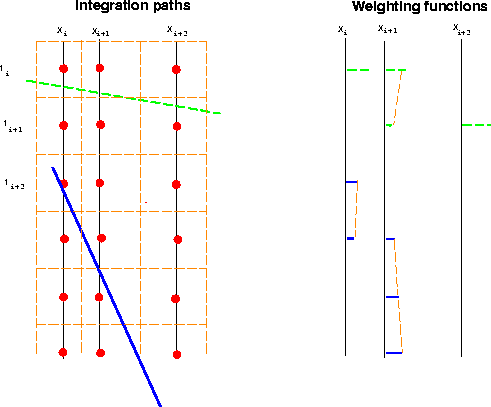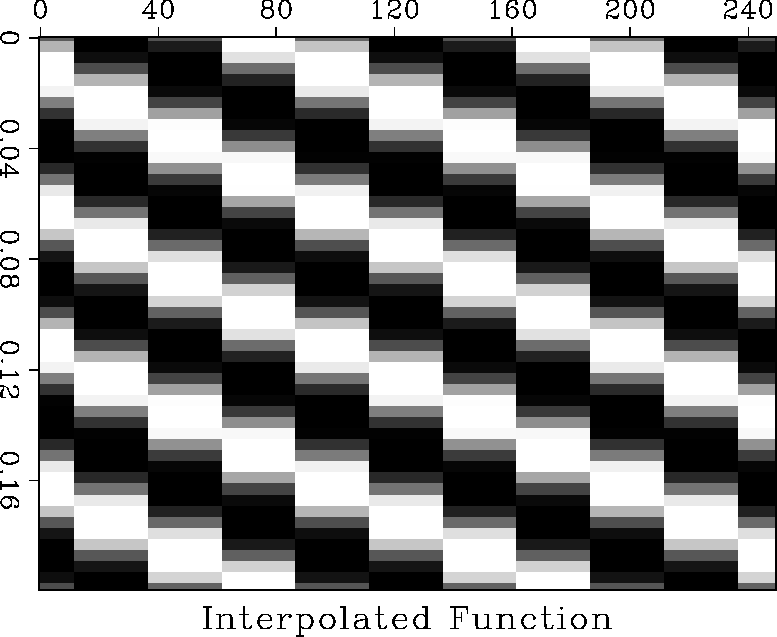




Next: Nearest neighbor in time,
Up: INTERPOLATION STRATEGIES
Previous: Continuous in time, linear
In this method I account for the fact that both time and space are
discretely sampled. Figure ![[*]](http://sepwww.stanford.edu/latex2html/cross_ref_motif.gif) shows the region subdivided
into cells. Within each cell the function value is approximated by the
value closest to the center of the cell.
shows the region subdivided
into cells. Within each cell the function value is approximated by the
value closest to the center of the cell.
The integral within a cell for this approximation is given by,

where  and
and  are the space coordinates at which the path enters and
leaves the cell. The integral along the whole path is the summation of a set of
constant values weighted by the width of the path that lies within each cell
(for a space integral.)
nnt-nns
are the space coordinates at which the path enters and
leaves the cell. The integral along the whole path is the summation of a set of
constant values weighted by the width of the path that lies within each cell
(for a space integral.)
nnt-nns
Figure 6 Nearest neighbor is space and time. The
function is approximated by a constant value in each cell. The weighting
function is the path width within the cell.

A cell is bounded by planes midway between the sample points.
There are three types of path through a cell.
- 1.
- When the integration path is near horizontal, it will lie completely within
one cell, the sample within that cell will then be scaled by the width
of the cell.
- 2.
- If the path passes completely through a cell from top to bottom, the sample
will be weighted by the width of the path within that cell. This width can be
calculated from the slope of the path.
- 3.
- There are also cases where the path
passes through the corner of a cell. In this case the width of the path within
the cell is a function of the point at which it enters the cell and the slope.
These three cases have to be dealt with separately when this method is
implemented. Note that because of the corner cases this method is not
a rectangular weight function on each sampled trace. The method of
rectangles proposed by Claerbout implicitly assumes that the path either
passes completely through a cell or misses it altogether.
Figure ![[*]](http://sepwww.stanford.edu/latex2html/cross_ref_motif.gif) shows the approximation to the original
function surface that is implied by this method. It is clear that for
some integration paths the integral through this surface will be a poor
approximation to the true integral.
shows the approximation to the original
function surface that is implied by this method. It is clear that for
some integration paths the integral through this surface will be a poor
approximation to the true integral.
nnxnnt-func
Figure 7 Input data sampled every 4ms in time
and 25m in space and then interpolated using nearest neighbor interpolation in
space and time.










Next: Nearest neighbor in time,
Up: INTERPOLATION STRATEGIES
Previous: Continuous in time, linear
Stanford Exploration Project
11/17/1997
![[*]](http://sepwww.stanford.edu/latex2html/cross_ref_motif.gif) shows the region subdivided
into cells. Within each cell the function value is approximated by the
value closest to the center of the cell.
shows the region subdivided
into cells. Within each cell the function value is approximated by the
value closest to the center of the cell.
![[*]](http://sepwww.stanford.edu/latex2html/cross_ref_motif.gif) shows the region subdivided
into cells. Within each cell the function value is approximated by the
value closest to the center of the cell.
shows the region subdivided
into cells. Within each cell the function value is approximated by the
value closest to the center of the cell.
![]()

![[*]](http://sepwww.stanford.edu/latex2html/cross_ref_motif.gif) shows the approximation to the original
function surface that is implied by this method. It is clear that for
some integration paths the integral through this surface will be a poor
approximation to the true integral.
shows the approximation to the original
function surface that is implied by this method. It is clear that for
some integration paths the integral through this surface will be a poor
approximation to the true integral.
